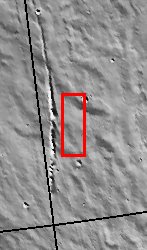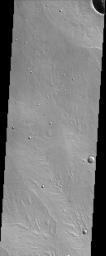- Original Caption Released with Image:
-

(Released 22 April 2002)
The Science
This image, centered near 46.5 N and 119.3 W (240.7 E), is on the northwestern flank of a large, broad shield volcano called Alba Patera. This region of Mars has a number of unique valley features that at first glance look dendritic much in the same pattern that rivers and tributaries form on Earth. A closer look reveals that the valleys are quite discontinuous and must form through a different process than surface runoff of liquid water that is common on Earth. A number of processes might have taken place at some point in the Martian past to form these features. Some of the broad valley features bear some resemblance to karst topography, where material is removed underground by melting or dissolving in groundwater causing the collapse of the surface above it. The long narrow valleys resemble surfaces where groundwater sapping has occurred. Sapping happens when groundwater reaches the surface and causes headward erosion, forming long valleys with fewer tributaries than is seen with valleys formed by surface water runoff. The volcano itself might have been a source of heat and energy, which played a role in producing surfaces that indicate an active groundwater system.
The Story
Fluid, oozing lava poured somewhat lazily over this area long ago. It happened perhaps thousands of times, over hundreds of thousands of Martian years, creating the nearly smooth, plaster-of-Paris-looking terrain seen today. (Small craters also dent the area, though they may deceive you and look like raised bumps instead. That's just a trick of the eye and the lighting - tilt your head to your left shoulder, and you should see the craters pit the surface as expected.)
The lava flows came from a Martian "shield" volcano named Alba Patera. Shield volcanoes get their name from their appearance: from above, they look like large battle shields lying face up to the sky as if a giant, geological warrior had lain them down. Perhaps one did if you think of a volcano as a "geologic warrior," that is. These volcanoes aren't too fierce, however. Because of the gentle layering of lava over time, they don't stand tall and angry against the horizon, but instead have relatively gentle slopes and are spread out over large areas. (On Earth, the Hawaiian Islands are examples of shield volcanoes, but you can't see much of their expanse, since they rise almost three miles from the ocean floor before popping out above the water's surface.)
What's most interesting in this picture are all of the branching features that lightly texture the terrain. The patterns may look like those caused by rivers here on Earth, but geologists say that no surface streams on Mars were responsible. That's no disappointment, however, to those who'd like to find water on Mars, because there are still intriguing water-related possibilities here.
Some of the broad valley features in this image look like karsts, a terrain found on Earth in Karst, a limestone area on the Adriatic Sea in modern-day Croatia, and in other world regions including France, China, the American Midwest, Kentucky, and Florida. Karst terrain on Earth is barren land with all kinds of caves, sinkholes, and underground rivers that excavate the subsurface, causing the surface above it to collapse. So, perhaps it's like that in this region on Mars as well. Future Martian spelunkers should be excited, because most caves on Earth are in karst areas.
Other suggestions of water here are some long, narrow valleys that resemble Earth surfaces where groundwater has sapped away the terrain. Sapping occurs when groundwater erodes slopes, creating valleys. Water action can be concentrated at valley heads, leading to what is called their "headward growth." That may be what has happened here on Alba Patera as well.
All of these features suggest the action of liquid water, but Mars is so cold, you might wonder if any water would have to be as frozen as the world it is on. Well . . . that depends! Remember that this area is part of a volcano, and volcanoes can put out enough heat and energy below the surface to keep water warm enough to flow - if not now, then at least in the past when the volcano was more active.
- Image Credit:
-
NASA/JPL/Arizona State University
Image Addition Date: -
2002-05-21
|

 Planetary Data System
Planetary Data System













